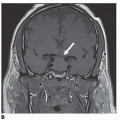10q11.2. More than 95% of MEN2 cases have been found to have such mutations. This “activating” gene encodes receptor tyrosine kinases, which signal cell growth and differentiation, and it starts tumor genesis. First, a germinal mutation occurs that increases cell susceptibility to malignant transformation; the second event is a somatic mutation that transforms the mutant cell into a tumor cell. In MEN2, there is a strong genotype-phenotype correlation.
Table 9.1. MEN: Organ or Feature Involvement with Estimated Penetrance in Adults | |||||||||||||||||||||||||||||||||||||||||||||||||||||||||||||||||||||||||||||||||||||||||||||||||||||||||||||||||||||||||||||||||||||||||||||||||||||||||||||||||||||||||||||||||||||||||||||||||||||||||||||||||||||||||||||||||||
|---|---|---|---|---|---|---|---|---|---|---|---|---|---|---|---|---|---|---|---|---|---|---|---|---|---|---|---|---|---|---|---|---|---|---|---|---|---|---|---|---|---|---|---|---|---|---|---|---|---|---|---|---|---|---|---|---|---|---|---|---|---|---|---|---|---|---|---|---|---|---|---|---|---|---|---|---|---|---|---|---|---|---|---|---|---|---|---|---|---|---|---|---|---|---|---|---|---|---|---|---|---|---|---|---|---|---|---|---|---|---|---|---|---|---|---|---|---|---|---|---|---|---|---|---|---|---|---|---|---|---|---|---|---|---|---|---|---|---|---|---|---|---|---|---|---|---|---|---|---|---|---|---|---|---|---|---|---|---|---|---|---|---|---|---|---|---|---|---|---|---|---|---|---|---|---|---|---|---|---|---|---|---|---|---|---|---|---|---|---|---|---|---|---|---|---|---|---|---|---|---|---|---|---|---|---|---|---|---|---|---|---|---|---|---|---|---|---|---|---|---|---|---|---|---|---|---|---|
| |||||||||||||||||||||||||||||||||||||||||||||||||||||||||||||||||||||||||||||||||||||||||||||||||||||||||||||||||||||||||||||||||||||||||||||||||||||||||||||||||||||||||||||||||||||||||||||||||||||||||||||||||||||||||||||||||||
second separate sample is recommended to reduce the risk of missing an affected to 0.25%. Thus far, false-positive mutation test results have not been reported, and the author is aware of no estimates of administrative, sampling, or reference laboratory errors.
only 26% and 31% of insulinomas and gastrinomas, respectively [26, 27]. EUS has reported sensitivity of 93% and specificity of 95% in the localization of intrapancreatic lesions [28]. In one case-control study of gastrinoma patients, EUS was 83% accurate, missing tumors in 4 and predicting nonexistent tumors in 2 of 36 patients (i.e., false-positive result) [29]. It was cost-effective, reducing localization costs by 50%. If these procedures are not successful, comparable sensitivity is possible with the more expensive and time-consuming percutaneous transhepatic transvenous sampling or with venous sampling for hormone measurement after arterial injection of secretagogue. Hepatic angiography is an excellent way to demonstrate hepatic metastases.
that multiple parathyroid glands are affected with a disease spectrum from hyperplasia of all glands through combinations of hyperplastic, adenomatous, and ectopically located disease. Parathyroid cancer occurs, but is rare [45]. Such multiplicity requires that all glands be identified at initial surgery; therefore, preoperative imaging studies are unnecessary and not cost-effective. We think that parathyroid operations in MEN1 patients should be done only by very experienced endocrine surgeons and that patients must understand before operation that, because of gland multifocality, recurrence is common, that reoperation is possible, and that hypoparathyroidism is possible.
Stay updated, free articles. Join our Telegram channel

Full access? Get Clinical Tree




